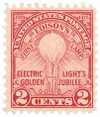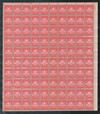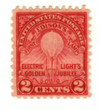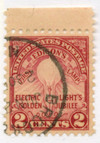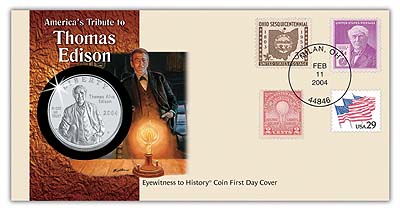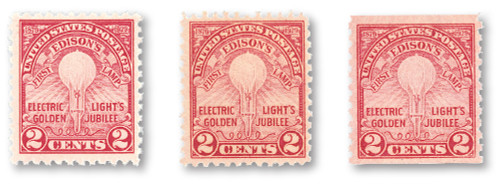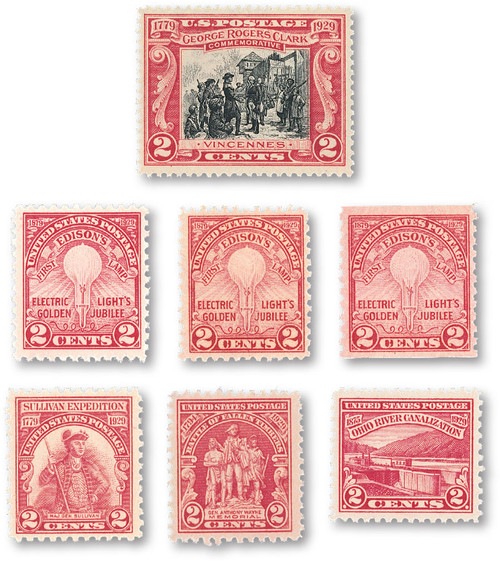
# 655 - 1929 2c Edison's First Lamp, rotary
1929 2¢ Edison's First Lamp
Rotary Press Printing
Issue Date: June 11, 1929
First City: Washington, DC
Quantity Issued: 210,119,474
Start Of The Electrical Age
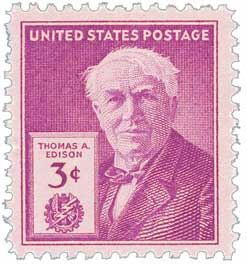
On September 4, 1882, Thomas Edison began providing electricity to a portion of New York City, an event often considered the start of the electrical age.
Electric arc lighting had existed since the early 1800s, but the frequent need to replace carbon tips and bright light meant these were best used outside or in very large rooms. Throughout the 1800s, inventors experimented with incandescent electric lighting for use indoors.
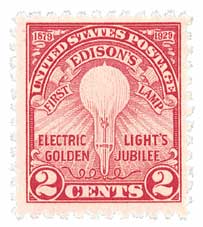
Though others had been exploring the idea for several years, Thomas Edison first grew interested in incandescent electric lighting in mid-1878. A little over a year later he successfully developed the first practical incandescent light. But he didn't stop there. He then set to work developing an entire system to generate, deliver, and utilize electric energy. He developed a parallel circuit, constant voltage dynamo, junction boxes, an underground conduit system, and several other components to run the system.
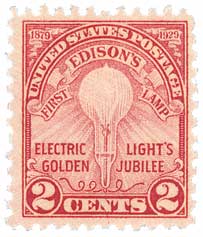
From the beginning, Edison had planned to institute a full-scale central system in New York City to prove that his system was commercially viable. He then set to work on the Pearl Street station, which would become the first permanent central power station to supply incandescent lighting. Edison carefully chose the location of his station, so that it would cover a densely populated area of both commercial and residential properties. The one-quarter square mile area, which came to be known as the First District, was home to the downtown business district and many influential newspapers.
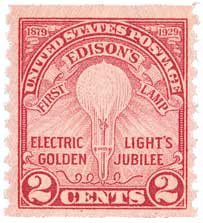
For the Pearl Street station, Edison developed six 27-ton constant-voltage dynamos that could each supply about 1,200 lamps. He also had to install 80,000 feet of underground conductors. Once the project was complete, Edison was ready to show it to the world. On September 4, 1882, he stood in the office of J. Pierpont Morgan of Drexel, Morgan & Company. He signaled his electrician at the station to close the switch, after which the power was delivered to the people in the First District. About 400 lamps were lit on that first day.
Though the event is now considered to a monumental moment in history, at the time it was largely uncelebrated. The New York Times briefly mentioned it in their Miscellaneous City News section. While the station wasn't an instant financial success, it proved Edison's system worked. It also expanded significantly to 10,000 lamps serving 513 customers within a year. Edison then built more stations in other parts of New York City and licensed similar systems for installation throughout America, Europe, and Japan over the next decade.
1929 2¢ Edison's First Lamp
Rotary Press Printing
Issue Date: June 11, 1929
First City: Washington, DC
Quantity Issued: 210,119,474
Start Of The Electrical Age

On September 4, 1882, Thomas Edison began providing electricity to a portion of New York City, an event often considered the start of the electrical age.
Electric arc lighting had existed since the early 1800s, but the frequent need to replace carbon tips and bright light meant these were best used outside or in very large rooms. Throughout the 1800s, inventors experimented with incandescent electric lighting for use indoors.

Though others had been exploring the idea for several years, Thomas Edison first grew interested in incandescent electric lighting in mid-1878. A little over a year later he successfully developed the first practical incandescent light. But he didn't stop there. He then set to work developing an entire system to generate, deliver, and utilize electric energy. He developed a parallel circuit, constant voltage dynamo, junction boxes, an underground conduit system, and several other components to run the system.

From the beginning, Edison had planned to institute a full-scale central system in New York City to prove that his system was commercially viable. He then set to work on the Pearl Street station, which would become the first permanent central power station to supply incandescent lighting. Edison carefully chose the location of his station, so that it would cover a densely populated area of both commercial and residential properties. The one-quarter square mile area, which came to be known as the First District, was home to the downtown business district and many influential newspapers.

For the Pearl Street station, Edison developed six 27-ton constant-voltage dynamos that could each supply about 1,200 lamps. He also had to install 80,000 feet of underground conductors. Once the project was complete, Edison was ready to show it to the world. On September 4, 1882, he stood in the office of J. Pierpont Morgan of Drexel, Morgan & Company. He signaled his electrician at the station to close the switch, after which the power was delivered to the people in the First District. About 400 lamps were lit on that first day.
Though the event is now considered to a monumental moment in history, at the time it was largely uncelebrated. The New York Times briefly mentioned it in their Miscellaneous City News section. While the station wasn't an instant financial success, it proved Edison's system worked. It also expanded significantly to 10,000 lamps serving 513 customers within a year. Edison then built more stations in other parts of New York City and licensed similar systems for installation throughout America, Europe, and Japan over the next decade.




